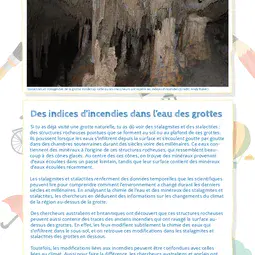Fire clues in cave dripwater
21 July 2016
If you’ve ever visited an underground cave, you’ve likely seen stalagmites or stalactites: spiky, rocky structures that form on the ground or the ceiling inside caves. They grow when water at the surface seeps down through the soil and drips into underground chambers over hundreds or thousands of years. The water contains minerals that build up over time as the water drips to form the rocky structures, which look a bit like ice cream cones. The centre of the cone holds minerals that came from water that dripped long ago, while the surface contains minerals from more recent dripwater. This means stalagmites and stalactites work as time capsules that scientists can use to study how the environment changed over the past hundreds or thousands of years. By looking into the chemistry of the water and the minerals in stalagmites and stalactites, researchers can find information about how the climate was changing above ground as these rocky structures formed. Now, researchers in Australia and the UK have found that the rocky structures can also be used to help trace past wildfires that burned above the cave. Fires change the chemistry of the water above ground, and these subtle changes leave traces in the stalactites and stalagmites that form when the water drips in the caves underground. The fire signals in cave dripwater look a lot like the signals for a change in climate, so scientists have to be careful not to confuse the two. The Australian and UK researchers compared the dripwater in a cave that had been affected by fire to dripwater at a cave (about 300 km away) that had the same climate but no fire. Since the dripwater chemistry was different between the two locations, the researchers knew they had identified the record of a fire rather than a change in climate. This research shows that we can learn more about the Earth’s past from caves than we previously thought.Find out more
Discuss with your teacher or parents
Why is it important to study caves and what can we learn from them?
How fast do stalagmites and stalactites grow?
To better understand how stalactites and stalagmites form, why not make your own? The simple experiment at http://www.sciencekids.co.nz/projects/stalactite.html will help you find out how minerals deposit to form rocky structures.
If you’d like to learn more about past, present and future climate changes and their impacts, check http://climatekids.nasa.gov/.
Print version

This is a kids' version of the EGU article: 'Fire clues in cave dripwater'. It was written by Bárbara Ferreira (EGU Media and Communications Manager), reviewed for scientific content by Anne Jefferson (Associate Professor, Kent State University, US) and Amelia Bulcock (PhD Student, Loughborough University, UK), and for educational content by Abigail Morton (Teacher, Chiang Rai International School, Thailand).
Translations








All English-language Planet Press releases are carefully edited, reviewed and proofed, by scientists, educators and EGU staff. Please note that once translated, Planet Press releases receive no further checks from EGU staff. For this reason, we cannot guarantee their accuracy, though we trust the quality of our voluntary translators and are grateful for their work.

